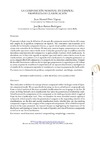Identificador persistente para citar o vincular este elemento:
https://accedacris.ulpgc.es/jspui/handle/10553/70668
| Campo DC | Valor | idioma |
|---|---|---|
| dc.contributor.author | Pérez Vigaray, Juan Manuel | en_US |
| dc.contributor.author | Batista Rodríguez, José Juan | en_US |
| dc.date.accessioned | 2020-03-05T11:32:10Z | - |
| dc.date.available | 2020-03-05T11:32:10Z | - |
| dc.date.issued | 2020 | en_US |
| dc.identifier.issn | 0212-4130 | en_US |
| dc.identifier.other | WoS | - |
| dc.identifier.uri | https://accedacris.ulpgc.es/handle/10553/70668 | - |
| dc.description.abstract | El presente trabajo trata de delimitar el concepto de compuesto nominal dentro del campo más amplio de las palabras compuestas en español. Nos centramos concretamente en el estudio de los llamados compuestos léxicos, y, a partir de un análisis crítico de las clasificaciones más conocidas de los últimos 30 años para nuestra lengua, proponemos una nueva clasificación que toma como criterio rector la relación gramatical que se establece entre los miembros constituyentes del compuesto y se aplica desde el primer nivel clasificatorio. Se abandona, así, la línea más seguida en español, que suele tomar como criterio rector de sus clasificaciones, en el primer y en el segundo nivel clasificatorio, la categoría gramatical, ya sea la categoría final del compuesto o la categoría de los elementos constituyentes. Después de describir brevemente cada uno de los tipos que proponemos, la segunda parte del trabajo se centra en poner de manifiesto la importancia de los aspectos diacrónicos y tipológicos en el estudio de los compuestos españoles (y románicos) y en nuestra propuesta de clasificación | en_US |
| dc.description.abstract | This study aims to delimit the concept of noun compound within the largest realm of Spanish compound words. We are specifically focusing on the so called lexical compounds and, from a critical analysis of the most extended classifications for our language in the last 30 years, we bring forward a new classification that takes the grammatical relationship established between the components of the compound as the leading criterion which is applied from the first classification level. Thus, we abandon the most extended research approach in Spanish, which usually takes the grammatical category as the organizing criterion of its classifications, on the first and second classification levels, whether they are the resulting compound category or the category of the compound components. After a brief description of each of the types presented, the research focuses on highlighting the importance of the diachronic and typological issues in the study of Spanish, and also of Romance compounds as well as in our own classification. | en_US |
| dc.language | spa | en_US |
| dc.relation.ispartof | Revista de Filología de la Universidad de La Laguna | en_US |
| dc.source | Revista de Filología de la Universidad de La Laguna [ISSN 0212-4130], n. 40, p. 205-245 | en_US |
| dc.subject | 550510 Filología | en_US |
| dc.subject.other | Modern Greek | en_US |
| dc.subject.other | History | en_US |
| dc.subject.other | Word Formation | en_US |
| dc.subject.other | Nominal Compounding | en_US |
| dc.subject.other | Morphology | en_US |
| dc.subject.other | Semantics | en_US |
| dc.subject.other | Formación de palabras | en_US |
| dc.subject.other | Composición nominal | en_US |
| dc.subject.other | Morfología | en_US |
| dc.subject.other | Semántica | en_US |
| dc.title | La composición nominal en español propuesta de clasificación | en_US |
| dc.title.alternative | Spanish compounding: a new proposal of classification | en_US |
| dc.type | info:eu-repo/semantics/Article | en_US |
| dc.type | Article | en_US |
| dc.identifier.doi | 10.25145/j.refiull.2020.40.11 | |
| dc.identifier.isi | 000514810100011 | - |
| dc.description.lastpage | 245 | - |
| dc.description.firstpage | 205 | - |
| dc.relation.volume | 40 | - |
| dc.investigacion | Artes y Humanidades | en_US |
| dc.type2 | Artículo | en_US |
| dc.contributor.daisngid | 11020885 | |
| dc.contributor.daisngid | No ID | - |
| dc.contributor.daisngid | No ID | - |
| dc.contributor.daisngid | 21031443 | |
| dc.identifier.external | 41 | - |
| dc.identifier.external | 41 | - |
| dc.identifier.external | 41 | - |
| dc.identifier.external | 41 | - |
| dc.identifier.external | 41 | - |
| dc.identifier.external | 41 | - |
| dc.description.numberofpages | 41 | - |
| dc.utils.revision | Sí | en_US |
| dc.contributor.wosstandard | WOS:Vigaray, JMP | |
| dc.contributor.wosstandard | WOS:Rodriguez, JJB | |
| dc.date.coverdate | Enero 2020 | |
| dc.identifier.ulpgc | Sí | es |
| dc.description.sellofecyt | Sello FECYT | |
| dc.description.esci | ESCI | |
| dc.description.fecytq | Q3 | |
| dc.description.fecytpuntuacion | 24,13 | |
| dc.description.dialnetimpact | 0,0 | |
| dc.description.dialnetq | Q2 | |
| dc.description.dialnetd | D4 | |
| dc.description.erihplus | ERIH PLUS | |
| item.grantfulltext | open | - |
| item.fulltext | Con texto completo | - |
| crisitem.author.dept | GIR Sociolingüística, fonética acústica y lingüística aplicada a la enseñanza | - |
| crisitem.author.parentorg | Departamento de Filología Hispánica, Clásica y de Estudios Árabes y Orientales | - |
| crisitem.author.fullName | Pérez Vigaray,Juan Manuel | - |
| Colección: | Artículos | |
Visitas
262
actualizado el 15-nov-2025
Descargas
251
actualizado el 15-nov-2025
Google ScholarTM
Verifica
Altmetric
Comparte
Exporta metadatos
Los elementos en ULPGC accedaCRIS están protegidos por derechos de autor con todos los derechos reservados, a menos que se indique lo contrario.
